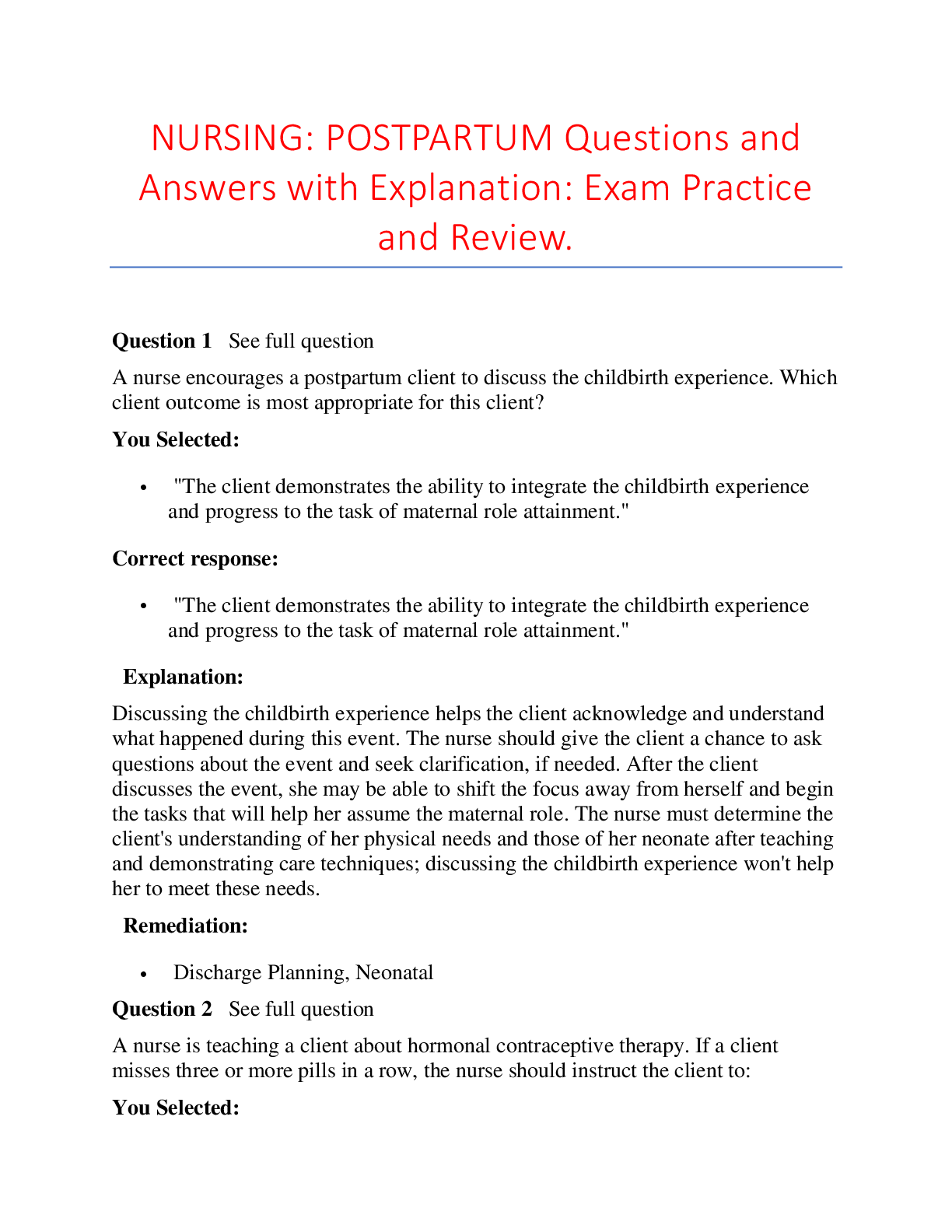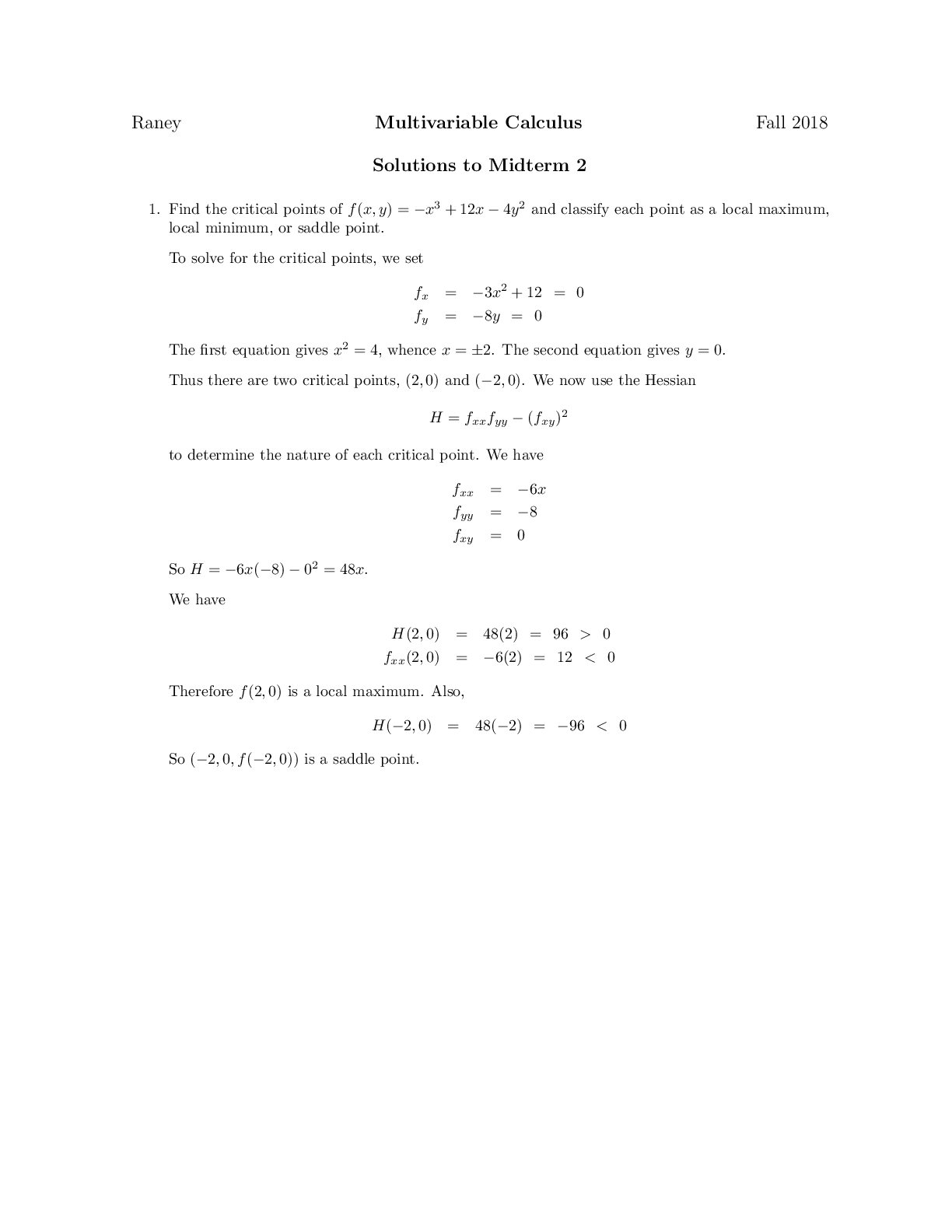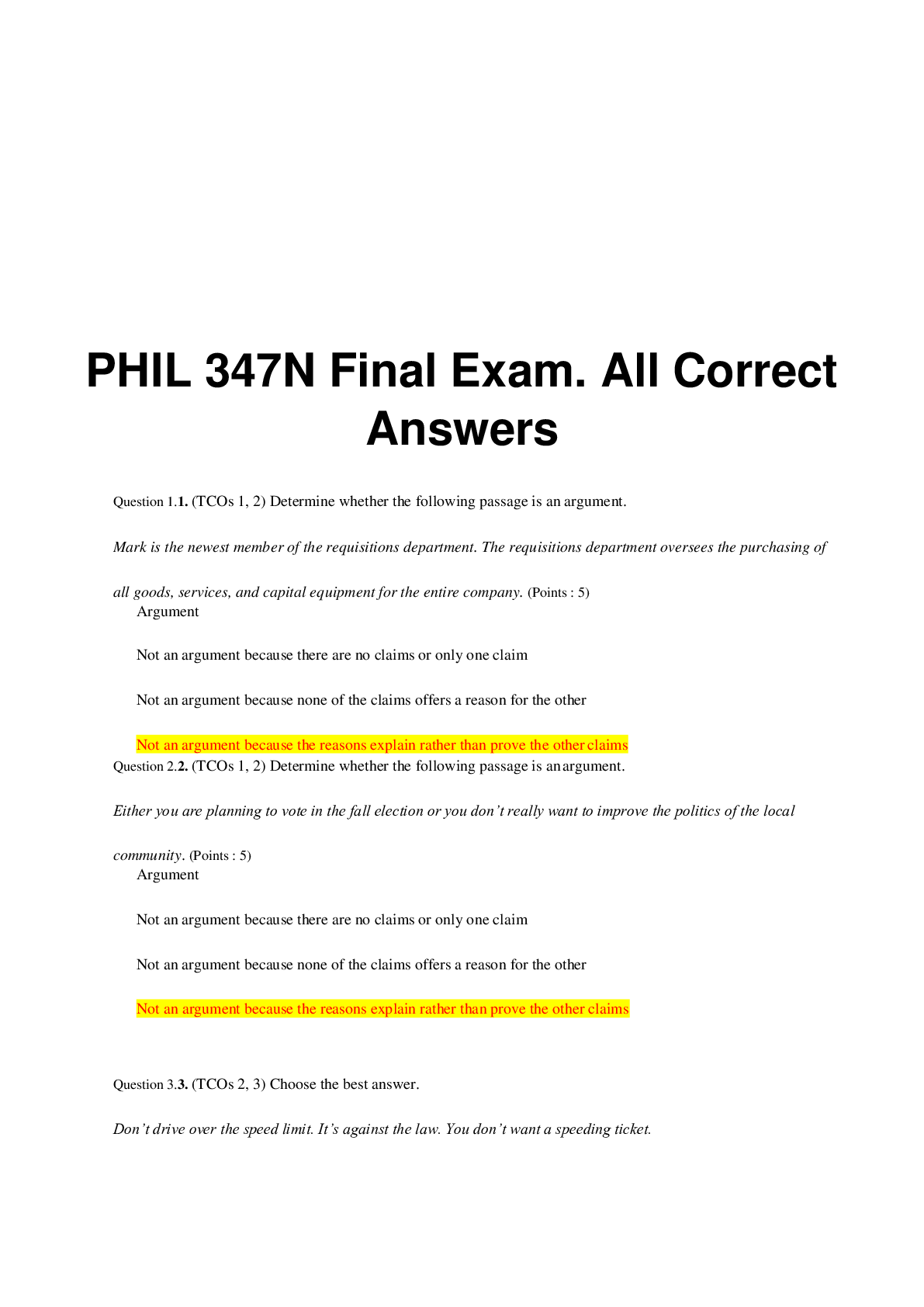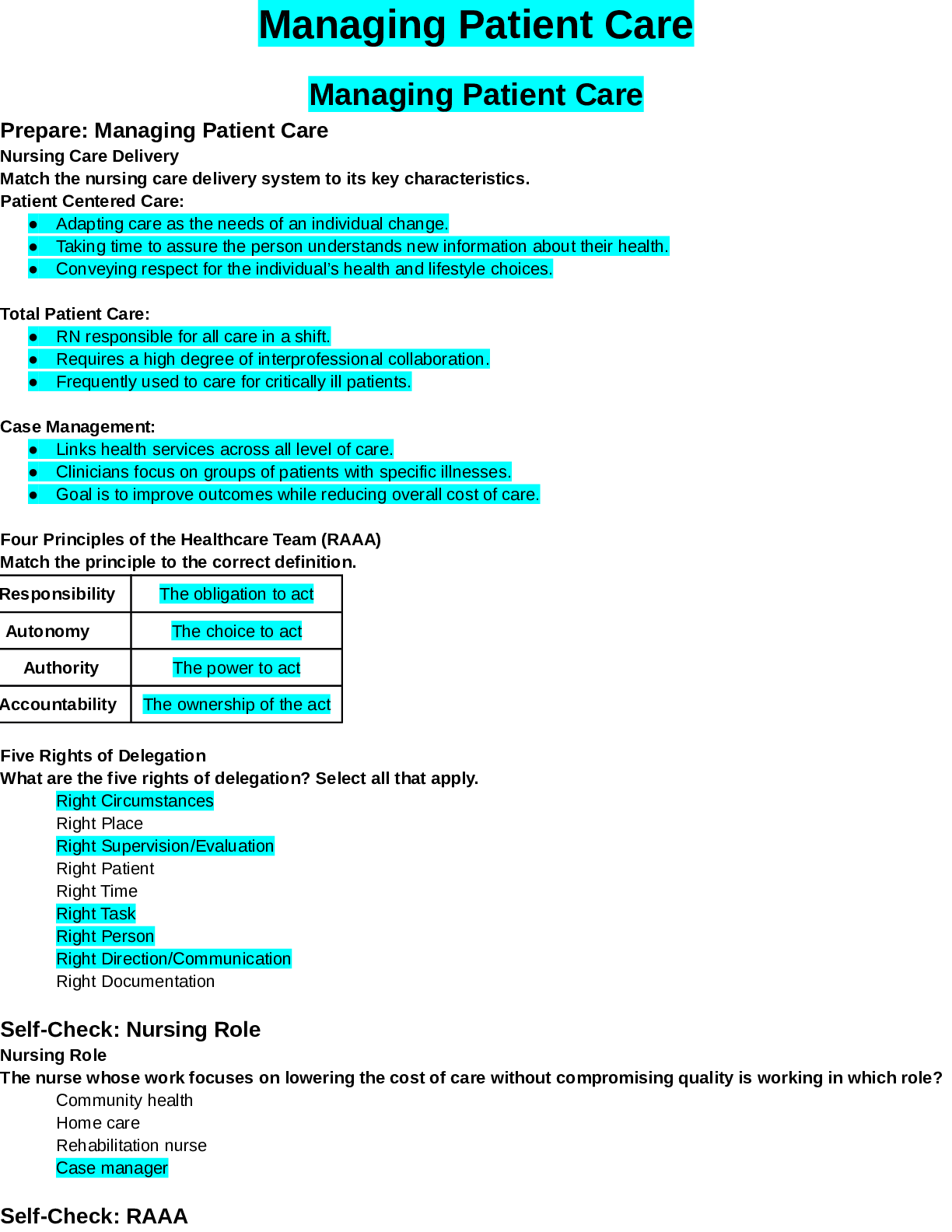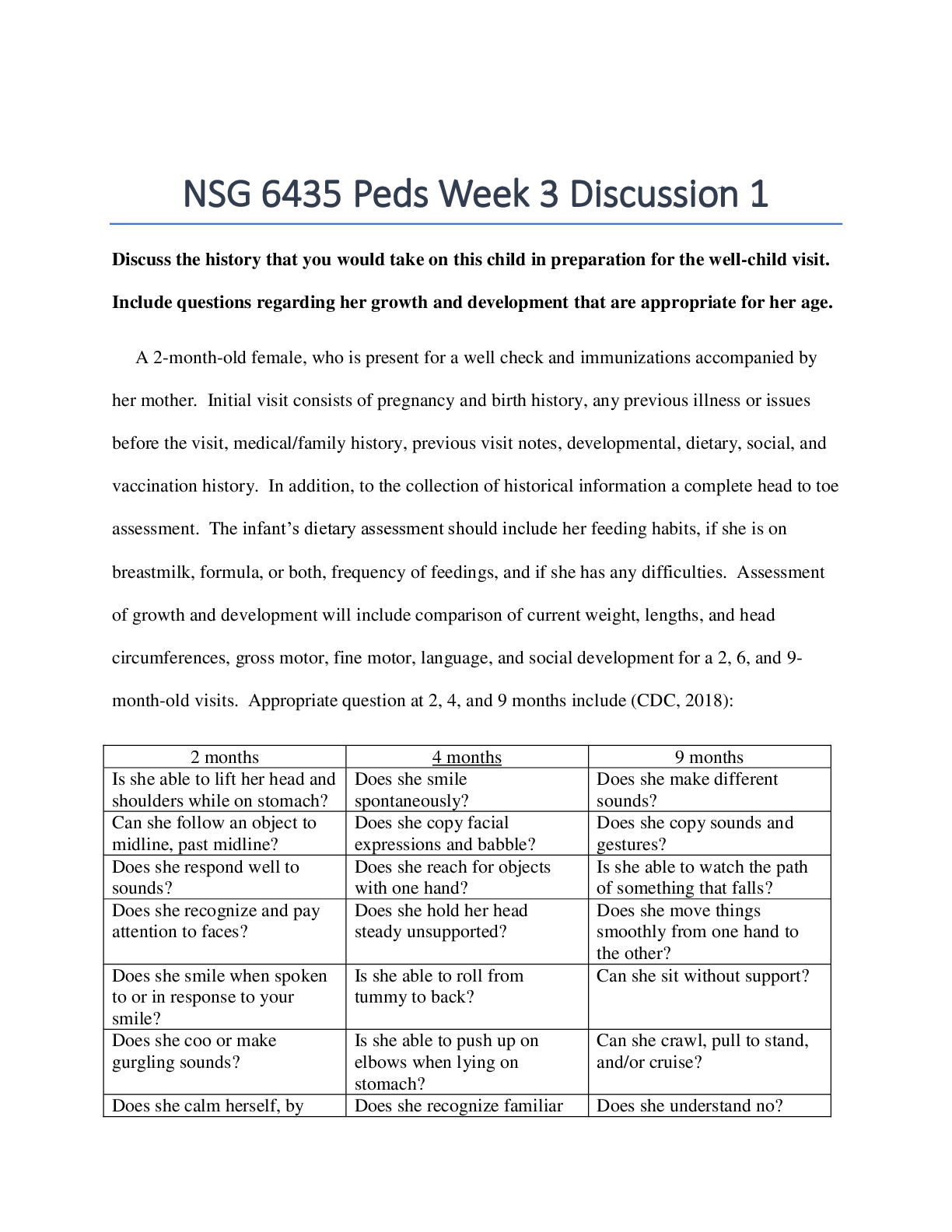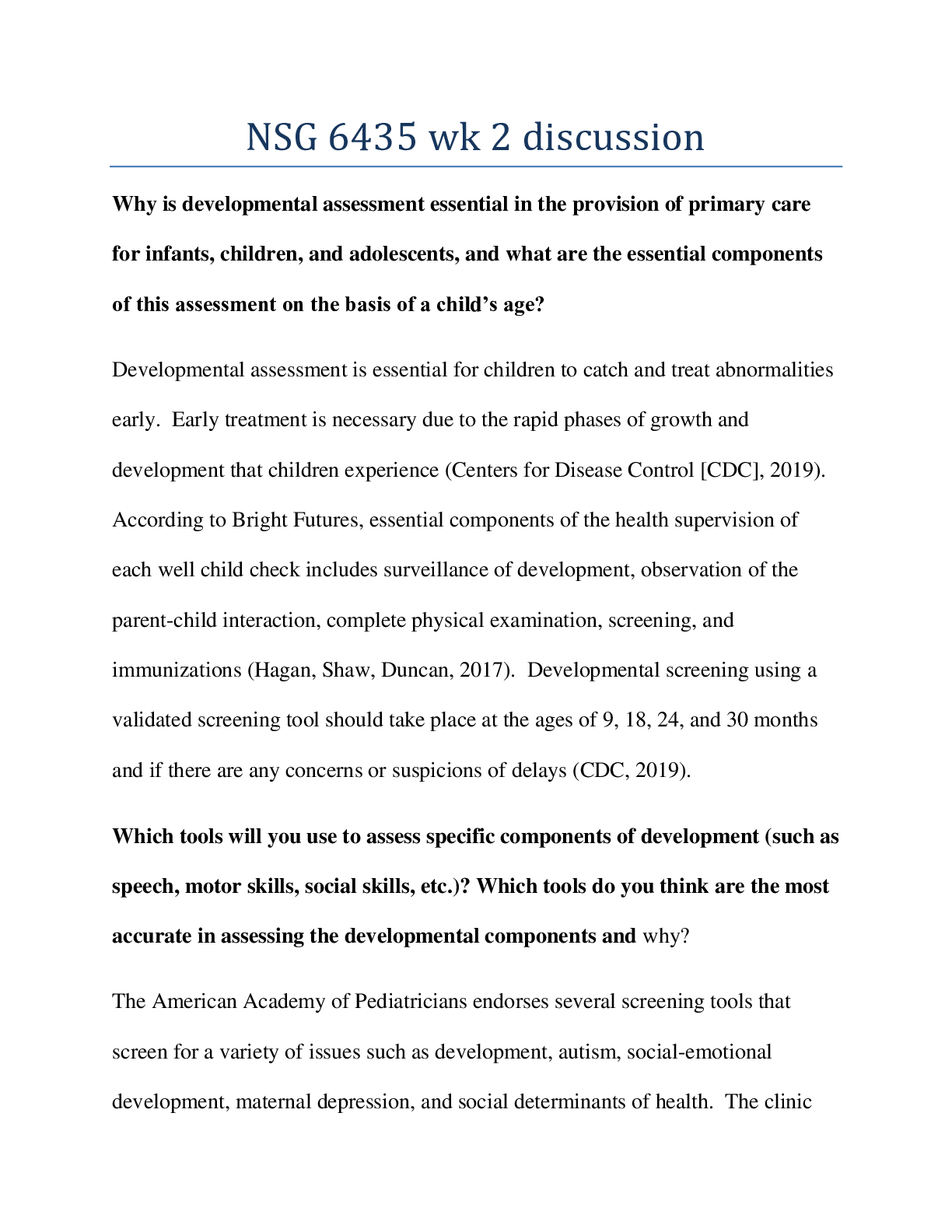*NURSING > QUESTIONS & ANSWERS > NUR 112 Evolve. Questions and Answers. And the Explanation. For A grade. 100%. (All)
NUR 112 Evolve. Questions and Answers. And the Explanation. For A grade. 100%.
Document Content and Description Below
NUR 112 Evolve. Questions and Answers The nurse recalls that which disease originates from B-cell blasts present in the lymph nodes? 1 Burkitt’s lymphoma 2 Hodgkin’s lymphoma 3 Diffuse large ... B-cell lymphoma 4 Non-Hodgkin’s lymphoma (NHL) A patient is suspected to have Hodgkin’s lymphoma. Which diagnostic test result does the nurse recognize as indicative of this disease? 1 Lymphoblasts in the cerebrospinal fluid 2 Reed-Sternberg cells in the lymph node 3 Hypercellular bone marrow with myeloblasts 4 Philadelphia chromosome in the bone marrow cells A patient is hospitalized with suspected Hodgkin’s lymphoma. The nurse expects what assessment finding? 1 Skeletal pain 2 Enlarged lymph nodes 3 B-cell blasts in the lymph node 4 Lymphoblasts in the cerebrospinal fluid Enlarged lymph nodes are a characteristic of Hodgkin’s disease that occurs in the initial stage of development. Skeletal pain is a characteristic of multiple myeloma. B-cell blasts in the lymph nodes indicate Burkitt’s lymphoma. Lymphoblasts in the cerebrospinal fluid are a diagnostic finding of acute lymphocytic lymphoma. The nurse recalls that which type of leukemia accounts for 80% of acute leukemia in adults? 1 Acute lymphocytic leukemia (ALL) 2 Acute myelogenous leukemia (AML) 3 Chronic lymphocytic leukemia (CLL) 4 Chronic myelogenous leukemia (CML) The nurse recognizes that which treatment option is appropriate for a patient diagnosed with chronic lymphocytic leukemia (CLL)? 1 α-interferons 2 Intrathecal methotrexate 3 Colony-stimulating factors 4 Autologous hematopoietic stem cell transplantation A patient is diagnosed with chronic lymphocytic leukemia (CLL). The nurse expects what diagnostic finding? 1 High lactate dehydrogenase 2 Low leukocyte alkaline phosphatase 3 Hypercellular bone marrow with myeloblasts Infiltration of lymphocytes into the bone marrow, spleen, and liver When a patient experiences a group of malignant disorders that affects the blood and blood-forming tissues of the bone marrow, lymph system, and spleen, the nurse identifies that what diagnosis will be made 1 Leukemia 2 Lymphoma 3 Polycythemia 4 Myelodysplastic syndrome The nurse recalls that which tests are considered primary methods for diagnosing leukemias? Select all that apply. Lumbar puncture # Bone marrow examination Peripheral blood evaluation Computed tomography (CT) scan 5 Morphologic and histochemical examination The nurse recognizes that which assessment finding is related to cognitive-perceptual health patterns in a patient with leukemia? 1 Nausea 2 Epistaxis 3 Sore throat 4 Easy bruising Initial treatment for a patient with refractory lymphoma has been unsuccessful. The nurse anticipates that which type of therapy will be prescribed next, to treat the aggressive lymphoma? 1 Vertebroplasty 2 Chemotherapy 3 Radiation therapy 4 Hematopoietic stem cell transplantation (HSCT) Which disease process has chromosomal translocations as its contributing factor? 1 Leukemia 2 Multiple myeloma 3Hodgkin’s lymphoma 4 Non-Hodgkin’s lymphoma When is consolidation therapy indicated in patients with leukemia? 1 After maintenance therapy 2 After remission is achieved In3 Immediately after induction therapy 4 Initially when the treatment is indicated A patient is suspected to have non-Hodgkin’s disease. The nurse anticipates a prescription for what diagnostic test to rule out central nervous system (CNS) disease? 1 Peripheral blood analysis 2 Bone marrow examination 3 Magnetic resonance imaging (MRI) 4 Positron emission tomography (PET) scan After an upper endoscopy with biopsy, a patient is diagnosed with Helicobacter pylori gastric lymphoma. What type of therapy does the nurse expect to find on the patient’s treatment plan of care? 1 Phototherapy 2 Antibiotic therapy 3 Radiation therapy 4 Topical chemotherapy The nurse expects that a patient will experience central nervous system manifestations with which type of leukemia? 1 Acute lymphocytic leukemia (ALL) 2 Chronic lymphocytic leukemia (CLL) 3 Acute myelogenous leukemia (AML) 4 Chronic myelogenous leukemia (CML) A patient is diagnosed with acute lymphocytic leukemia (ALL). The nurse identifies that which assessment finding is associated with the diagnosis? 1 Lymphadenopathy 2 Gingival hyperplasia 3 Leukemic meningitis 4 Hepatosplenomegaly A patient is diagnosed with acute lymphocytic leukemia (ALL). Which diagnostic finding supports the conclusion? 1 Low leukocyte alkaline phosphatase 2 Increase in the platelet count and RBC count 3 Hypercellular bone marrow with myeloblasts 4 Transverse lines of rarefaction at the ends of metaphysis of the long bones The nurse assesses enlarged retroperitoneal nodes in a patient with Hodgkin’s lymphoma. The nurse should monitor the patient for which complication? 1 Paraplegia In2 Liver dysfunction 3 Renal dysfunction 4 Superior vena cava syndrome The nurse recalls that which therapy is appropriate to be prescribed for both indolent and aggressive non-Hodgkin’s lymphoma (NHL)? 1 Radioimmunotherapy 2 Intrathecal chemotherapy 3 Hematopoietic stem cell transplant (HSCT) 4 Combination of chemotherapy with localized radiation A patient is undergoing aggressive chemotherapy treatment, during which the patient becomes critically ill. The nurse recognizes that the findings indicate that the patient is in which stage of chemotherapy? 1 Induction therapy 2 Maintenance therapy 3 Consolidation therapy 4 Intensification therapy A patient with Hodgkin’s lymphoma experiences sensory and motor impairment of the lower limbs. What does the nurse suspect to be the cause of this condition? 1 Bone involvement 2 Intrathoracic involvement 3 Spinal cord compression 4 Enlarged retroperitoneal nodes An adult patient is diagnosed with acute myelogenous leukemia (AML). The nurse explains to the patient that collaborative care will focus on what? 1 Leukapheresis 2 Attaining remission 3 One chemotherapy agent 4 Waiting with active supportive care Which non-Hodgkin’s lymphoma is included in the classification of T-cell and NK-cell lymphomas? 1 Burkitt’s lymphoma 2 Mantle cell lymphoma 3 Lymphoblastic lymphoma 4 Small lymphocytic lymphoma Several minutes after the start of a transfusion of packed red blood cells, the patient reports itching. Hives begin to develop on the patient’s chest and abdomen. Which immediate action should the nurse take? 1 Slow the rate of the transfusion 2 Stop the transfusion immediately 3 Dilute the blood with normal saline solution 4 Obtain a prescription for an antihistamine A patient is scheduled for a hematopoietic stem cell transplant (HSCT) and receives preoperative combination chemotherapy. What is the nursing priority? 1 Prevent patient infection 2 Avoid abnormal bleeding 3 Give pneumococcal vaccine 4 Provide companionship while isolated Which process does the nurse recognize as occurring in stage IV of Hodgkin’s non-Hodgkin’s lymphomas? 1 Involvement of a single lymph node 2 Involvement outside of the diaphragm 3 Involvement of lymph nodes above and below the diaphragm 4 Involvement of two or more lymph nodes on one side of the diaphragm The nurse recognizes that which diagnostic study is helpful in determining the clinical stage of Hodgkin’s lymphoma? 1 Barium enema 2 Upper endoscopy 3 Magnetic resonance imaging (MRI) 4 Positron emission tomography (PET) with CT scan The nurse provides information about non-Hodgkin’s lymphoma to a group of nursing students. What is appropriate to be included in the education about the disease? 1 It is localized to regional nodes. In2 It involves common B symptoms. 3 It has rare extranodal involvement. 4 It is a group of malignant neoplasms. Which term is used to indicate the solid masses that result from collection of leukemic cells? 1 Purpura 2 Petechiae 3 Chloromas 4 Ecchymosis The nurse recalls that which system of the body is most commonly affected by leukemia? In1 Immune system 2 Digestive system 3 Central nervous system 4 Musculoskeletal system Which type of lymphoma originates from lymph nodes, usually in the neck or abdomen? 1 Burkitt’s lymphoma 2 Diffuse large B-cell lymphoma 3 Small lymphocytic lymphoma (SLL) 4 Chronic lymphocytic leukemia (CLL) It is suspected that a patient is experiencing tumor lysis. The nurse should prepare the patient for what diagnostic study? 1 Blood test 2 Barium enema 3 Upper endoscopy 4 Computed tomography (CT) The patient is being treated for non-Hodgkin's lymphoma (NHL). The nurse identifies that the most important teaching that should be provided to the patient is related to what topic? 1 Skin care that will be needed 2 Method of obtaining the treatment 3 Gastrointestinal tract effects of treatment 4 Treatment type and expected side effects When caring for a patient with leukemia, the nurse expects what assessment finding that occurs due to thrombocytopenia? 1 Pallor 2 Fever 3 Bruising 4 Weakness The nurse recalls that which type of leukemia accounts for 80% of acute leukemia in adults? 1 Acute lymphocytic leukemia (ALL) 2 Acute myelogenous leukemia (AML) 3 Chronic lymphocytic leukemia (CLL) 4 Chronic myelogenous leukemia (CML) The nurse recalls what information about the Philadelphia chromosome’s role in leukemia? 1 It interferes with normal cell cycle events. In2 It is specific to diagnoses of chronic myelogenous leukemia (CML). 3 It is present in 40 to 50 percent of patients with acute lymphocytic leukemia (ALL). 4 It is present in 50 to 70 percent of patients with chronic myelogenous leukemia (CML). A patient completed a course of treatment for Hodgkin’s lymphoma. The nurse anticipates that which diagnostic study will be performed to differentiate the residual tumor from fibrotic masses? 1 Upper endoscopy 2 Peripheral blood analysis 3 Magnetic resonance Imaging (MRI) 4 Positron emission tomography (PET) The nurse is caring for a patient with leukemia. The nurse recalls that which condition may occur due to infiltration of leukemic cells in the patient's body systems? 1 Anemia 2 Leukostasis 3 Thrombocytopenia 4 Meningeal irritation The nurse recalls that which disease originates from B-cell blasts present in the lymph nodes? 1 Burkitt’s lymphoma 2 Hodgkin’s lymphoma 3 Diffuse large B-cell lymphoma 4 Non-Hodgkin’s lymphoma (NHL) A patient with leukemia experiences frequent infections and fever. The nurse recalls that the pathophysiologic events that cause the clinical manifestations occur in what order? In 1. Blast cells replace bone marrow In 2. Suppression of immunity in the body In 3. Leukemia causes increase in the number of blast cells In 4. Decrease in the number of lymphocytes A patient diagnosed with advanced-stage Hodgkin's lymphoma reports fever, night sweats, and weight loss. The nurse recognizes that which medication may be beneficial? 1 Prednisone 2 Methotrexate 3 Mitoxantrone 4 Tositumomab The nurse assesses the vital signs of a patient with lymphoma and notes a blood pressure of 80/60 mm Hg and an irregular cardiac rhythm. Which medication does the nurse suspect is causing the condition? 1 Iron 2 Rituximab 3 Azacitidine 4 Zoledronic acid The diagnostic findings of a patient with leukemia indicate the presence of the Philadelphia chromosome and excessive lymphoblasts in the bone marrow and cerebrospinal fluid. The patient reports frequent episodes of fever, nausea, vomiting, and lethargy. The nurse anticipates a prescription for which medication that will be administered intrathecally? 1 Rituximab 2 Methotrexate 3 Alemtuzumab In4 Arsenic trioxide A patient is hospitalized with a new diagnosis of non-Hodgkin’s lymphoma. The nurse expects to find what nonspecific clinical manifestation associated with this disease? 1 Anemia 2 Hyperuricemia 3 Splenomegaly 4 Lymphadenopathy A patient reports the type B symptoms of night sweats, fever, and weight loss. The nurse suspects that the patient is experiencing what disease process? 1 Multiple myeloma 2 Chronic lymphocytic leukemia 3 Non-Hodgkin’s lymphoma 4 Acute myelogenous leukemia A patient with cancer experiences fever, drenching night sweats, and weight loss. The laboratory reports show intrathoracic involvement. The nurse should monitor the patient for which complication? 1 Bone pain 2 Paraplegia 3 Renal failure 4 Superior vena cava syndrome A patient with leukemia asks the nurse, "What causes the reddish-purplish colored spots on my skin?" The nurse should explain that the spots are due to what condition? 1 Low platelet count 2 Low neutrophil count 3 Low erythrocyte count 4 Low lymphocyte count The nurse is caring for a patient with suspected mediastinal lymphadenopathy. The nurse anticipates that which diagnostic test will be performed? 1 Barium enema 2 Upper endoscopy 3 Radiologic evaluation 4 Positron emission tomography (PET) The nurse provides education to a patient with leukemia that is receiving chemotherapy. What is appropriate for the nurse to include in the teaching? In1 "The treatment has severe side effects, some of which will be permanent." 2 "You need to use your call light to ask for help every time you get out of bed." 3 "You can feel free to communicate your problems to me; don’t think that you are isolated." 4 "You shouldn’t discuss quality-of-life issues with your friends; the conversation will make them feel uncomfortable." The nurse notes that the diagnostic studies of a leukemia patient indicate normal bone marrow and peripheral blood, and the physical examination does not show any evidence of disease. Which term is used to refer to this patient’s condition? 1 Partial remission 2 Complete remission 3 Molecular remission 4 Minimal residual disease The nurse monitors a patient with multiple myeloma for resulting bone degeneration. What clinical manifestations may be indicative of this complication? Select all that apply. 1 Diarrhea 2 Seizures 3 Oliguria 4 Anorexia 5 Confusion The nurse reviews the medical record of a patient with acute lymphocytic leukemia (ALL) and notes documentation of the patient experiencing CNS leukemia. The nurse anticipates that which drugs will be prescribed? Select all that apply. In1 Rituximab 2 Cytarabine 3 Methotrexate 4 Alemtuzumab 5 Arsenic trioxide The nurse reviews the medical record of a patient with leukemia and sees notation that the leukemic cells may infiltrate the patient’s organs. The nurse anticipates that which diagnostic studies will be prescribed? Select all that apply. 1 Lumbar puncture In2 Morphologic study In3 Histochemical study 4 Cytogenetic method 5 Computed tomography A competent patient is hospitalized with suspected internal bleeding. The patient states, "I am a Jehovah’s Witness and do not want to receive any blood products if they are needed." Shortly after admission, the patient becomes unconscious. It is determined that the patient needs packed red blood cells (pRBCs). What is the nurse’s most appropriate action? 1 Withhold the blood products. 2 Contact the agency’s ethics committee. 3 Contact the family for permission to administer blood products to the patient. 4 Administer blood products with the intent of informing the patient after the procedure. The diagnostic findings of a patient indicate uncontrolled proliferation of myeloblasts. The nurse anticipates that what drugs will be prescribed for induction therapy? 1 Imatinib + dasatinib 2 Cytarabine + idarubicin 3 Rituximab + alemtuzumab 4 6-mercaptopurine + carmustine The nurse identifies that which patient’s findings indicate chronic myelogenous leukemia (CML)? 1 Patient A 2 Patient B 3 Patient C 4 Patient D Imatinib is prescribed as treatment for leukemia. What is its mechanism of action? 1 Inhibits angiogenesis In2 Inhibits cell proliferation 3 Targets BCR-ABL protein 4 Causes DNA fragmentation Assessment findings of a patient with Hodgkin's lymphoma include involvement of the lymph nodes above and below the diaphragm. The patient reports fever, night sweats, and weight loss. The nurse identifies that the patient is in what clinical stage of the disease? 1 Stage IIIA 2 Stage IIIB 3 Stage IVA 4 Stage IVB The nurse is caring for a young adult recently diagnosed with acute myelogenous leukemia (AML). The onset of the illness was abrupt, and family members are attempting to adjust to the patient’s sick role. Identify characteristics of the sick role. Select all that apply. 1 The patient becomes withdrawn. 2 The patient becomes dependent. 3 The patient remains as independent as possible. 4 The patient’s family role and responsibilities are altered. 5 The patient refuses to stop working contrary to the primary health care provider’s advice. A patient is in a limited stage of cutaneous T-cell lymphoma. Which treatment administered by the oncology nurse would be most beneficial for this patient? 1 Phototherapy 2 α- Interferon therapy 3 Topical chemotherapy 4 Oral bexarotene therapy The assessment findings of a patient include a decreased RBC and platelet counts and the presence of hypercellular bone marrow with lymphoblasts. The patient reports nausea, vomiting, and lethargy. The nurse expects the patient to be diagnosed with which type of leukemia? 1 Acute lymphocytic leukemia (ALL) In2 Acute myelogenous leukemia (AML) 3 Chronic lymphocytic leukemia (CLL) 4 Chronic myelogenous leukemia (CML) Cranial radiation therapy and intrathecal methotrexate are prescribed for a patient. The nurse suspects that the patient has which type of leukemia? 1 Acute lymphocytic leukemia (ALL) 2 Acute myelogenous leukemia (AML) 3 Chronic lymphocytic leukemia (CLL) 4 Chronic myelogenous leukemia (CML) A patient that reports recent weight loss, fever, and night sweats is diagnosed with chronic lymphocytic leukemia. The nurse expects what dianostic findings? Select all that apply. 1 Hepatomegaly 2 Sternal tenderness 3 Hemoglobin 19 g/dL 4 Platelet count 50,000/mcL 5 White blood cell count 110,000/mcL Which cells are involved in the origin of Burkitt’s lymphoma? 1 Reed-Sternberg cells 2 B-cell blasts in the lymph nodes 3 Lymphoblasts in cerebrospinal fluid 4 Hyper cellular bone marrow with myoblasts A patient with acute lymphocytic leukemia (ALL) asks for clarification about the disease. The nursing response should be based on which understanding of the disease? 1 ALL is infectious in nature and characterized by increased white blood cells 2 ALL is malignant in nature and characterized by increased circulating red blood cells 3 ALL is inflammatory in nature and characterized by solid tumor formation in the lymph nodes 4 ALL is malignant in nature and characterized by a proliferation of immature white blood cells The nurse that is caring for a group of patients identifies that the patient with what condition is at the greatest risk for the development of Hodgkin’s lymphoma? 1 Myeloma 2 Bone marrow suppression 3 Burkitt’s non-Hodgkin’s lymphoma (NHL) 4 Human immunodeficiency virus (HIV) infection The diagnostic findings of a patient indicate accumulation of small, mature-appearing lymphocytes in the bone marrow. The nurse identifies that the patient is most likely experiencing what disorder? 1 Acute lymphocytic leukemia (ALL) 2 Acute myelogenous leukemia (AML) 3 Chronic lymphocytic leukemia (CLL) 4 Chronic myelogenous leukemia (CML) After reviewing the diagnostic reports of a patient, the nurse suspects that a patient is experiencing acute lymphocytic leukemia (ALL) based on which findings? Select all that apply. 1 Presence of increased number of myeloblasts 2 Presence of lymphocytes in cerebrospinal fluid 3 Presence of hypercellular bone marrow with lymphoblasts 4 Presence of accumulated small, mature-appearing lymphocyte 5 Excessive development of mature neoplastic granulocytes in the bone marrow A patient is being treated with chemotherapy for the treatment of non-Hodgkin’s lymphoma. The nurse anticipates a prescription for what combination therapy that is both an indolent and aggressive therapy? 1 FND (Fludarabine, mitoxantrone[novantronel], dexamethasone) 2 FMC (Fludarabine, mitoxantrone, cyclophosphamide) 3 RICE (Rituximab, ifosfamide, cyclophosphamide, etoposide) 4 R-CHOP (Rituximab, cyclophosphamide, doxorubicin hydrochloride) In which order would the nurse respond to a patient receiving a blood transfusion who is suspected of experiencing an acute transfusion reaction? 1. Stop the transfusion and maintain a patent IV line with a normal saline infusion. 2. Notify the blood bank and health care provider immediately. 3. Recheck identifying tags and numbers on blood bag. 4. Monitor vital signs and urine output frequently. In 5. Document transfusion reaction. In 6. Treat patient symptoms as prescribed. In 7. Send blood bag and tubing for examination. A patient with non-Hodgkin's lymphoma is prescribed rituximab (Rituxan). To reduce the side effects of the medication, the nurse expects that which preliminary assessments will be performed? Select all that apply. 1 Screening the patient for a history of hepatitis 2 Evaluating the patient for a history of seizures 3 Serial monitoring of the patient's renal function 4 Monitoring the patient for bone marrow suppression 5 Monitoring the patient for hypersensitivity infusion reactions Which drug used to treat acute promyelocytic leukemia acts by causing DNA fragmentation and cell death? In1 Imatinib 2 Rituximab 3 Alemtuzumab 4 Arsenic trioxide The nurse is reviewing the diagnostic follow-up of patients with leukemia after their treatment. Which patient has minimal residual disease? 1 Patient A In2 Patient B 3 Patient C 4 Patient D The nurse provides education to a group of nursing students about Hodgkin’s lymphoma. What is appropriate to be included in the teaching? Select all that apply. 1 Extranodal involvement is rare. 2 Treatment includes chemotherapy. 3 Long-term survival exceeds 85% for all stages. 4 The extent of the disease is disseminated widely. 5 B symptoms, such as fever, drenching night sweats, and weight loss, are common. A patient with respiratory distress experiences a white blood cell count of more than 100,000 cells/µL. Immediate treatment has been prescribed. The nurse suspects that the patient is experiencing what condition? In1 Lymphoma 2 Leukostasis 3 Neutropenia 4 Thalassemia After receiving chemotherapy treatments for leukemia, a patient is declared to be in partial remission. Which statement does the nurse identify as being true about partial remission? 1 All molecular studies for residual leukemia are negative. 2 Tumor cells cannot be detected by morphologic examination, but they are present in molecular testing. In3 There is no evidence of overt disease on examination, and the bone marrow and peripheral blood are normal. 4 There is a lack of symptoms and a normal peripheral blood smear, but evidence of the disease is still present in bone marrow. A patient with leukemia is being seen for a follow-up visit, following a course of treatment. The patient no longer experiences symptoms, and the peripheral blood smear is normal. There is still evidence of disease in the bone marrow. The nurse identifies that the patient is in which stage of disease control? 1 Partial remission 2 Complete remission 3 Molecular remission 4 Minimal residual disease The nurse provides education to a group of nursing students about hematopoietic stem cell transplantation (HSCT) therapy as treatment for acute lymphocytic leukemia (ALL). What is appropriate for the nurse to include in the education? 1 HSCT is not associated with any infections. 2 There will not be any relapse chances after HSCT. 3 Allogeneic HSCT does not lead to graft-versus-host disease. 4 HSCT involves eradication of patient’s hematopoietic stem cells. The nurse recognizes that which type of leukemia is characterized by the proliferation of immature small lymphocytes in the bone marrow? 1 Acute lymphocytic leukemia (ALL) 2 Acute myelogenous leukemia (AML) 3 Chronic lymphocytic leukemia (CLL) 4 Chronic myelogenous leukemia (CML) The nurse assesses hepatomegaly and neurologic symptoms in a patient with central nervous disease. The nurse recalls that the symptoms are characteristic of which disease? 1 Multiple myeloma 2 Hodgkin’s lymphoma 3 Non-Hodgkin’s lymphoma (NHL) 4 Acute lymphocytic lymphoma (ALL) The diagnostic findings of a patient with chronic myelogenous leukemia indicate the presence of the Philadelphia chromosome. The patient’s plan of care includes a drug that targets the genes responsible for the origin of the Philadelphia chromosome. The nurse expects that what medication will be prescribed? 1 Imatinib 2 Doxorubicin 3 Methotrexate 4 Mercaptopurine Imatinib acts by targeting the BCR-ABL protein. The Philadelphia chromosome, which is present in 90 to 95 percent of patients with chronic myelogenous leukemia, originates from a translocation between the BCR gene on chromosome 22 and the ABL gene on chromosome 9. Doxorubicin acts by directly binding to the DNA and inhibiting its synthesis. Methotrexate acts by interfering with folic acid metabolism. Mercaptopurine acts by interfering with purine metabolism. Which information does the nurse include in the objective data while documenting a patient with leukemia’s data? 1 Impotence 2 Prolonged menses 3 Low platelet count 4 Klinefelter syndrome A patient with human immunodeficiency virus (HIV) demonstrates signs of bowel perforation. The nurse suspects that which condition may have caused this complication? 1 Polycythemia 2 Multiple myeloma In3 Hodgkin’s lymphoma 4 Non-Hodgkin’s lymphoma A patient with leukemia is undergoing maintenance therapy. The nurse recalls what information about this course of treatment? 1 It is the high-dose treatment given immediately after induction therapy. 2 Chemotherapy is given every three to four weeks for a prolonged period. 3 Intensification and consolidation are the terms used to describe this therapy. 4 70 percent of patients with leukemia achieve complete remission after this therapy. The nurse reviews a treatment plan of a patient with leukemia that is receiving chemotherapy. The plan includes low doses of chemotherapy every three or four weeks. Which stage of chemotherapy does this indicate? 1 Induction therapy 2 Maintenance therapy 3 Consolidation therapy 4 Intensification therapy A patient with leukemia reports nausea, vomiting, and lethargy. The diagnostic findings indicate meningitis. The nurse suspects that what diagnosis will be made? 1 Acute lymphocytic leukemia (ALL) 2 Acute myelogenous leukemia (AML) 3 Chronic lymphocytic leukemia (CLL) 4 Chronic myelogenous leukemia (CML) A patient with cancer experiences weight loss, weakness, fever, tachycardia, and a hemoglobin of 7.4 mg/dL. What complication does the nurse suspect may be occurring? 1 Multiple myeloma 2 Hodgkin’s lymphoma 3 Non-Hodgkin’s lymphoma 4 Acute lymphocytic leukemia A patient takes immunosuppressive medication for the treatment of psoriatic arthritis. The nurse identifies that the patient is at risk for what complication related to this treatment regimen? 1 Multiple myeloma 2 Hodgkin’s lymphoma 3 Non-Hodgkin’s lymphoma 4 Myelodysplastic syndrome A patient reports weight loss, fever, drenching night sweats, and painless lymph node enlargement. The nurse recognizes that the symptoms may be indicative of which diseases? Select all that apply. 1 Burkitt’s lymphoma 2 Hodgkin’s lymphoma 3 Myelodysplastic syndrome 4 Peripheral T-cell lymphoma 5 Human immunodeficiency viral infection The nurse reviews a patient’s diagnostic results which reveal the presence of Reed-Sternberg cells. The nurse recalls that the cells are indicative of what condition? 1 Polycythemia 2 Multiple myeloma 3 Hodgkin’s lymphoma In4 Non-Hodgkin’s lymphoma The white blood cell count of a patient with leukemia is 120,000 cells/µL. The nurse identifies that which emergency treatment would be most beneficial for the patient? 1 Leukapheresis 2 Antitumor antibiotic 3 Monoclonal antibodies 4 Hematopoietic stem cell transplantation A patient is suspected to have leukemia. The nurse anticipates a prescription for which diagnostic test that detects leukemic cells outside of the blood and bone marrow? 1 Bone marrow examination 2 Peripheral blood evaluation 3 Computed tomography (CT) scan 4 Morphologic and cytogenetic methods A treatment plan for a patient being treated for non-Hodgkin’s lymphoma includes a radioactive isotope. The nurse anticipates a prescription for what therapeutic agent? 1 Carfilzomib 2 Fludarabine 3 Ofatumumab 4 Ibritumomab tiuxetan A patient receives a prescription for rituximab. Prior to administering the medication, the nurse should check the patient’s history for which condition? 1 Hepatitis 2 Migraine attack 3 Vitamin D deficiency 4 Vitamin A deficiency The treatment plan for a patient with chronic lymphocytic leukemia (CLL) includes a drug that acts by binding to CD52, a panlymphocyte antigen present on both T and B cells. The nurse anticipates that what drug will be prescribed? 1 Lomustine 2 Carboplatin 3 Alemtuzumab 4 Cyclophosphamide The nurse assesses tiny red spots on the skin of a patient with leukemia.. The nurse recalls that the events that led to the red spots occur in what chronologic order? In 1. Decrease in the platelet count In 2. Petechiae due to bleeding In 3. Leukemia leads to high count of immature white blood cells In 4. Blast cells replace bone marrow A patient with acute myelogenous leukemia (AML) has completed the prescribed cycles of cytotoxic chemotherapy, and documentation indicates that the patient is in partial remission. How should the nurse interpret this documentation? 1 No tumor cells were detected by morphologic examination, but can be identified by molecular testing. 2 Physical examination reveals no evidence of the disease, and the bone marrow and peripheral blood appear normal. 3 Symptoms are absent, and there is a normal peripheral blood smear, but there is evidence of the disease in the bone marrow. 4 There are no physical symptoms or bone marrow abnormalities, and molecular studies are negative for residual leukemia. A patient is diagnosed with Hodgkin’s lymphoma, which originated from the diaphragm. The nurse anticipates that the patient will undergo testing of which organ? 1 Neck 2 Liver 3 Spleen 4 Abdomen When obtaining subjective data from a patient with leukemia, which question should the nurse ask? In1 "Did you have seizures, decreased coordination, and confusion?" 2 "Did you undergo chemotherapy and radiation therapy for cancer?" 3 "Did you experience gingival bleeding and oral ulcerations frequently?" 4 "Did you observe reddish brown to purple spots on your body in the past six months?" The nurse prepares to administer rituximab to a patient. The nurse recognizes that the medication is appropriate for what disorders? Select all that apply. 1 Follicular lymphoma 2 Mantle cell lymphoma 3 Peripheral T-cell lymphoma 4 Cutaneous T- cell lymphoma 5 Human Immunodeficiency Virus (HIV) ositron emission tomography (PET) with computed tomography (CT) scan reveals the presence of mediastinal lymphadenopathy in a patient diagnosed with Hodgkin’s disease. The nurse recalls that these procedures can also identify what other abnormalities? Select all that apply. 1 Bone erosion 2 Hypoferremia 3 Brain infiltration 4 Liver and spleen infiltration 5 Abnormal lymph node enlargement The oncology nurse is administering chemotherapy to a group of patients with non- Hodgkin’s lymphoma. A patient with which type of lymphoma will most likely have the best outcome with indolent therapy? 1 Burkitt’s lymphoma 2 Follicular lymphoma 3 Mantle cell lymphoma 4 Peripheral T-cell lymphoma A patient with non-Hodgkin’s lymphoma (NHL) develops tumor lysis syndrome. For which complication should the nurse monitor? In1 Jaundice 2 Bone pain 3 Paraplegia 4 Renal failure The nurse provides education to a group of student nurses about the staging system of Hodgkin’s and non-Hodgkin’s lymphomas. Which statement made by a student nurse indicates the need for further teaching? 1 "In stage I, there is an involvement of a single lymph node." 2 "In stage IV, there is an involvement outside the diaphragm." 3 "In stage III, there is lymph node involvement above and below the diaphragm." 4 "In stage II, there is an involvement of two or more lymph nodes on both sides of the diaphragm." A patient is diagnosed with non-Hodgkin’s lymphoma. The nurse expects what clinical manifestation? 1 Hyperuricemia 2 Airway obstruction 3 Pericardial tamponade 4 Painless lymph node enlargement The nurse cares for a patient that reports drenching night sweats, chills, fever, and rapid pulse rate. The patient’s hemoglobin level is 8.4 mg/dL. To determine a diagnosis, what tests will be performed? Select all that apply. 1 Lumbar puncture 2 Prothrombin time 3 Peripheral blood analysis 4 Bone marrow examination 5 Computed tomography (CT) An initial emergency plan of care for a patient with leukemia includes leukapheresis and hydroxyurea. The nurse concludes that the treatments were prescribed based on which laboratory parameter? 1 Hemoglobin of 9 g/dL 2 Platelet count of 90,000/µL 3 WBC count of 120,000 cells/µL 4 Lactate dehydrogenase 300 U/L The nurse identifies that the stages of chemotherapy for the treatment of leukemia are administered in what order? 1. Induction therapy 2. Intensification therapy 3. Consolidation therapy 4. Maintenance therapy The oncology nurse is caring for a patient with marginal zone B-cell lymphoma. The nurse expects that what combination of chemotherapy will be prescribed? 1 Ifosfamide, cyclophosphamide, etoposide (ICE) 2 Fludarabine, cyclophosphamide, mitoxantrone, rituximab (FCMR) 3 Steroids, methotrexate, ifosfamide, L-asparaginase, etoposide (SMILE) 4 Dexamethasone, high-dose cytarabine (Ara-C), cisplatin (Platinol), with rituximab (DHAP±R) A patient with leukemia is hospitalized. Which piece of information obtained by the nurse during the patient’s admission process should be documented under the subjective data section? 1 Gingival bleeding 2 Exposure to chemical toxins 3 Presence of Philadelphia chromosome 4 Presence of reddish brown cutaneous infiltrates The nurse provides information to a student nurse about the stages of chemotherapy for a patient with leukemia. Which statement made by the student indicates effective learning? 1 "The patient becomes critically ill during consolidation therapy." 2 "Consolidation therapy is an aggressive treatment to destroy leukemic cells." 3 "Induction therapy is used to eliminate the leukemic cells that are clinically not evident." 4 "Maintenance therapy involves treatment with lower doses of drugs for a prolonged period." The nurse anticipates that which combinations of chemotherapeutic agents will be prescribed during induction therapy for a patient with acute myelogenous leukemia? Select all that apply. 1 Cytarabine + idarubicin 2 Cytarabine + rituximab 3 Cytarabine + daunorubicin 4 Cytarabine + ofatumumab 5 Cytarabine + mitoxantrone A patient with non-Hodgkin’s lymphoma asked the nurse why a lumbar puncture has been prescribed. What rationale should the nurse give? In1 It helps establish cell type. 2 It helps establish cell pattern. 3 It helps rule out bone marrow infiltration. 4 It helps rule out central nervous system involvement. A patient is diagnosed with Hodgkin’s lymphoma that involves the bone and the liver. The nurse expects what diagnostic findings? Select all that apply. 1 Hypercalcemia 2 Hypoalbuminuria 3 Hypogammaglobulinemia 4 Autoimmune hemolytic anemia 5 Idiopathic thrombocytopenic purpura A patient is treated with chemotherapy for Burkitt’s non-Hodgkin’s lymphoma (NHL). The nurse should monitor the patient for what complication? 1 Renal dysfunction 2 Tumor lysis syndrome 3 Peripheral neuropathy 4 Fluid electrolyte imbalances [Show More]
Last updated: 2 years ago
Preview 1 out of 51 pages
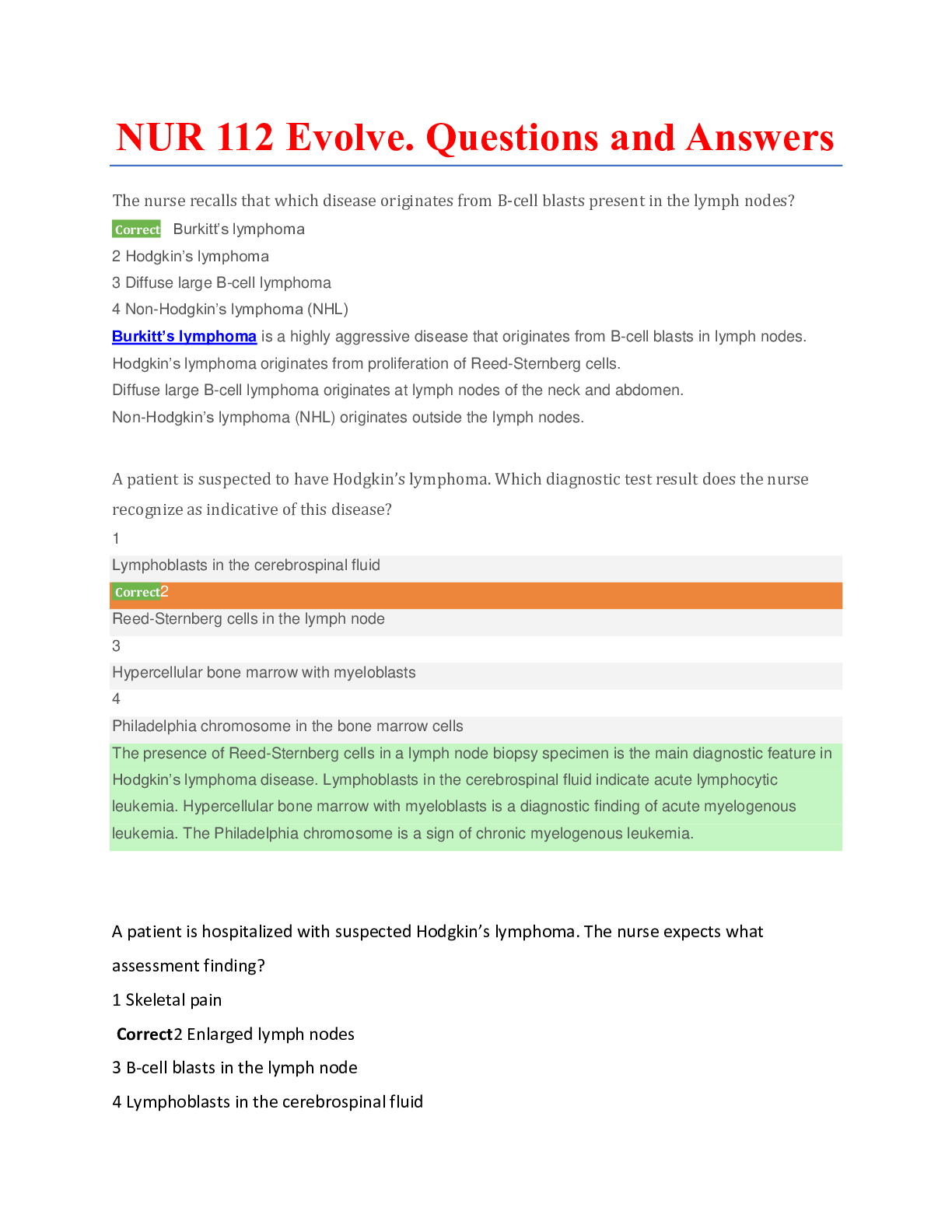
Buy this document to get the full access instantly
Instant Download Access after purchase
Buy NowInstant download
We Accept:

Reviews( 0 )
$8.50
Can't find what you want? Try our AI powered Search
Document information
Connected school, study & course
About the document
Uploaded On
Aug 11, 2020
Number of pages
51
Written in
Additional information
This document has been written for:
Uploaded
Aug 11, 2020
Downloads
0
Views
111

